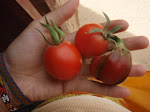 Narba and granddaughter Harira
Narba and granddaughter HariraIn Niger, a typical woman has less than three years of education, and the life expectancy of a girl born today is only 45. Only four per cent of Nigerien women use modern contraception, and one child in four never reaches the age of 5. At this rate, every mother is likely to suffer the loss of a child during her lifetime. Source: CBC News
6/10/08
Lately I've really been appreciating the evenings. It's a time when more people are gathered at home, talking or sitting or eating (women with the kids, men separate, of course). I find myself staying out a little later each evening, picking up strands of conversation, contributing some, mostly listening, laughing at the kids, whose antics--in the dirt and ash and whatever they can roll their naked little bellies in--are often the focus of our attention. Children are so precious here. I don't know why I was surprised to see the tenderness with which Narba treats every one of her grandkids, great grandkids, and neighbors' kids. Maybe because there are SO MANY babies, kids, everywhere, 4,5,6,7,8 per woman, as many as 10,20,30 per husband if he has several wives; maybe I assumed that they were somehow less special, less treasured in the eyes of old women, who in their lives have held hundreds of babies. But it is not that way; it is the opposite, and it squashed my assumptions absolutely. To see Narba goyo (tie to her back) her daughter-in-law's baby, Harira, of 4 months, and carry her all over the village proudly, is seeing a happy woman doing what she has done since she was a girl herself.I will often come upon Narba at her home, sitting on a mat in the shade, with a half dozen of her family's babes napping or crawling or playing around her--and Narba is totally into it, singing for them or clapping or chuckling. Last night Rabi had batteries for a radio, so we listened to some afro pop, and immediately a crowd of bouncing toddlers was gleefully stomping in the dust...Narba, delighted, rushed to get her flashlight to shine on them in the dark. Together we watched them, their brown legs and arms, pumping, kicking, bottoms falling into the sand, turning them a lighter brown. They were so funny. But mostly I watched Narba, who had eyes only for them; she clucked and sang and held that light over them, exclaiming "Toh! Gareka! Toh!" (Hey! Yo! You got it! Yeah!))
So, you see, these babies, all gazillion of them, they are beloved. And it's not just Narba, it's everyone, all of the women who dote on every baby, the men who hold friends' babies in the afternoon, and the kids, who as soon as they're big enough, hope to carry a baby around, too.
Me in my village, and kids in Hamdallaye














